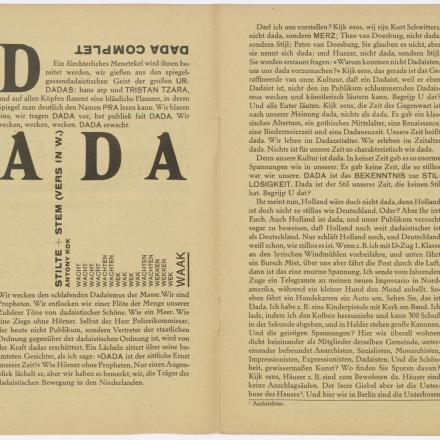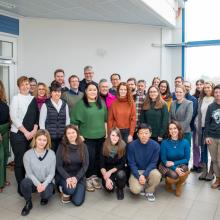Kurt Schwitters' Intermedia Networks of the Avant-garde
The Merz Series (1923-1932) and Merz-"Drucksachen"

Project Management: Dr. Isabel Schulz (Sprengel Museum Hannover) · Sprengel Museum Hannover · Prof. Dr. Ursula Kocher (Bergische Universität Wuppertal - Forschungsstelle Kurt Schwitters) · Bergische Universität Wuppertal · Dr Thomas Burch (Universität Trier - Trier Center for Digital Humanities (TCDH)) · Universität Trier - Trier Center for Digital Humanities (TCDH)
Project Participants: Sprengel Museum Hannover · Kurt und Ernst Schwitters Stiftung
Sponsors: Deutsche Forschungsgemeinschaft (DFG)
Running time: -
Contact person (TCDH): Dr Thomas Burch; Dr Matthias Bremm
References:
Kocher, Ursula und Schulz, Isabel (Hrsg.): Die Reihe Merz 1923–1932, Kurt Schwitters. Alle Texte, Band 4.: De Gruyter, 2019. https://doi.org/10.1515/9783110624113
Research Area: Software Systems and Research Infrastructure, Digital Literary and Cultural Studies
Keywords: LaTeX, “born digital”, Hybrid Edition, Printed Edition, 20th century, Exhibition Concept
Website of the Project: All of Schwitters - Kurt Schwitters. All texts
The author, artist and typographer Kurt Schwitters (Hanover 1887-1948 Kendal) pursued a comprehensive art concept as a Dadaist in the 1920s and 1930s, which he called Merz. The basic ideas of Merz, which form the basis and cohesion of Schwitters' oeuvre, are the independence of art from structural and media boundaries given and the use of any 'foreign' material for the artistic design. To make MERZIDEE a reality, Schwitters created a series of magazines of the same name that appeared from 1923 to 1932, a multimedia platform that was exclusively dedicated to his vision. Today, parts of his work can now be presented digitally in form of a hybrid edition.
KURT Merz SCHWITTERS - Alpha version
The Hybrid Edition Could Emerge
Although the Merz-magazines represent a unique document of the interwar period, the structure-disrupting diversity of forms and topics resulted in a lack of examination with regard to their journalistic organization as a magazine as well as their cross-material and art-form contributions. On the one hand, the project wanted to explore the special features of Merz in terms of content, structure and design in an interdisciplinary manner and, on the other hand, to integrate the series into Schwitters' entire oeuvre and into the complex avant-garde environment to which it is comprehensively related.
For this purpose, terminology and representation options were first developed that were suitable to grasp the multi-layered material. In the end, the user now has a hybrid edition (online and book publication) with comments, accompanying texts and extensive reference structures.
New Perspectives for the Field of Electronic Scientific Publishing are Shown
Both the digital mapping of the work processes within the project and the conception, development and UX design of the digital research platform touch on issues from the field of digital humanities. In this respect, the implementation of the project at the Trier Center for Digital Humanities (TCDH) was also an example of modern visualization and the technical possibilities in the DH. The project "Kurt Schwitters' Intermedial Networks of the Avant-garde - The Merz Series (1923-1932) and Merz-Drcuksachen", thus, not only makes an interdisciplinary contribution to Schwitters research, but also contributes to the expansion of literary instruments and shows future perspectives for the area of electronic scientific publishing.
Contemporary Forms of Visualization and Representation were Developed by the TCDH Team
The TCDH team (Roland Dahm, Martin Sievers, Dr. Matthias Bremm und Yu Gan) developed the technical and graphic infrastructure for this, which is essentially based on the work, publication and information platform FuD. After the relevant sources and information had been fed into the virtual research environment, all editorial work steps could be carried out collaboratively. This concerned, for example, the inventory of the individual numbers in the Merz series, the semantic and typographical recording of the text and image elements with the transcribo transcription tool and the subsequent saving of the transcripts, comments and content indexing in the FuD database. From FuD, it was possible to build a print edition with the typesetting system LaTeX and a suitable graphical internet-based user interface with the Content Management System TYPO3, which makes the high degree of hypertextuality of the material visible and provides differentiated navigation and research options.
Team TCDH
Dr Matthias Bremm
E-mail: bremm uni-trier [dot] de
uni-trier [dot] de
Phone: +49 651 201-2679
Dr Thomas Burch
E-mail: burch uni-trier [dot] de
uni-trier [dot] de
Phone: +49 651 201-3364










